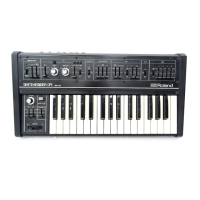Real-Time Patch
Changes
To
get the most
musical vitality
out ot
your SH-09,
alter
its sound while
you are
actually
playing
to
add
interest
and remove
predictability.
Change
the
sound
as you play
by adding/removing/or
altering
Portamento.
Change waveforms
or envelope
shapes.
Discover useful
variations
of
patches or
different
patches which are very
close in
settings
and
may evolve
from
one to the other
as you paly.
The
concept of
'evolving'
one patch
to another
is
1
9
also
useful
for
developing
speed
and
accuracy
for
on-stage
patching.
You
can find
'chains'
of
patches
which
require
only
simple
changes
to move from
one
to the next,
yet give
significant
new
sounds
and
a
large
change
from
the
beginning
of
the
chain
to the end.
Basic
String
to Brass
to Tuba
to
Bass
Guitar is
a good
example—
changing
VCF
Cutoff
and Envelope
Mod,
then
Range
and finally
the
ADSR
settings through
the
chain
and
find
adjusting
other controls
as
you
go
Custom
Patches
Making
your
own
patches to match a sound
you
have
heard
or
are
imaging
is
very rewarding,
but
often
avoided
as loo difficult'.
Many musicians
just
'fiddle'
until they
get
what
they
want or
what
they
are
willing
to
settle for,
play patches
out
of
books
without
tailoring
them
to
suit
or play the
same
sound all
the
time.
Mastering your
own
patches
is
not
all that
difficult—
only requiring
a certain
amount
of
experience
and practice,
and
a logical
approach.
A summary
of
one such
approach
is
presented
at
the
end of the
Patches
section of
this
manual. Work
your
way through
the Patches
given,
try
customizing
them
to your own
needs, then
try
creating
your own
sounds
and you will
get the
most
out
of
the
SH-09's vast potential.
There
are several
pitfalls or
traps which
are
com-
mon
with
synthesists working
on
new
patches.
Awareness
of them
can eliminate
several
and
minimize
others.
Sounds
created in
your imagination
present
special
problems.
These totally
abstract
ideas are
hard to
hold on
to, and tend
to
fade
away or evolve
into
other
ideas. Your
mind has
a tendency
to
accept
your new
patch
as
'correct'
when
you know
that it
isn't—
the idea
you
are
trying
to hold in your
mind
slips
over
and
becomes the
sound it hears. The
only
answers
are concentration
to hold the idea
and
speed to complete
the patch
while your
idea
is still clear
in your
mind.
Set up basic
parameters
before
you
listen
and work
quickly
to give your
ear
the least
temptation
be distracted
and change.
Listen
carefully
to any
sound you wish
to
copy. Do
not
be fooled
by
an
emotional
reaction
to the effect
of the
sound,
listen
to the sound
itself. A Violin
may
sound rich
and sweet
to
a
listener
according
to his
emotional
response,
but the
sound itself is
very
bright, with
a
bit
of
a buzz
in
the tone color.
Learn
to analyse sounds quickly
and accrately.
Reference
to a
record or
tape
will help
keep
you
on
the right
track and
is good
practice,
but don't
get too hung
up
with
absolute
precision— your
audience won't
be
making
side-by-side
comparisons
as you play
No sound
created by a
synthesizer
is actually com-
plete until it reaches the ear of
the listener.
You
must not only consider your
o> amplification,
effects and room
acoustics but
listen for those
same things in instruments or
sounds
you
wish
to
imitate.
Listen
for reverb,
phasing or
flanging,
wash
pedals,
or any other influences
over
a sound
including specialised amplification
such
as
over-
driving
a
small amp
to get a particularly
hot lead
sound.
Pay
particular attention to reverb.
Acoustic
instru-
ments are played in settings
with varying
amounts
of
natural reverberation—
the time it
takes
a sound
to -die away
to
silence
as it
bouces around the
room.
This effectively extends
the 'Release'
time of
those instruments. Many
electric/electronic
instru-
mentalists
achieve this 'room'
effect with
a reverb
unit within
their amplification
equipment
or
as an
extra in their
amplification chain. If
you
have
no
reverb
available, your
sound may seem
flat and
two
dimensional. To
compensate,
add
just a touch
of
extra Release length
to your
settings
—
this will
simulate
the extra 'ring' of room
acoustics. Listen
to
sounds
you wish
to use
on
your
synthesizer
as they
appear on
records. Sounds
like Strings
are usually
recorded
in or simulate
the sound
of
a
large
hall
(lots of reverb),
and many
synthesizer
sounds
recorded
by the great
players
use large amounts of
reverb in
the studio
—
your
sound won't
measure
up to theirs
unless you take reverb
into
account
STYLE
One last
but
very
important note: every
patch is
created with
a
certain musical or
performance style
in
mind and will
sound its
best
only when
played
in
a similar style. A wind
instrument patch will
sound odd if
you do not put rests in
at
regular
intervals for
the 'player"
to
'breathe'.
The listener
may not know
what is wrong,
but
often
will sense
the omission when he
should be subconsciously
appreciating
the
extra
attention
to
detail. A
lead
solo
patch intended
for lyric
music
lines
with
subtle
pitch
bending will
sound
entirely
different
if
played
in
a ripping
fast line with
wild
pitch
bending.
Copy-
ing
other
sounds and
styles
need not
be negative
or
un-creative
—
many
new
styles are born
from
an
understanding
of
previous
work
and borrow
from
others. If
you admire
a particular
performer or
sound,
don't
just go after
the
sound,
you must
study the
style.

